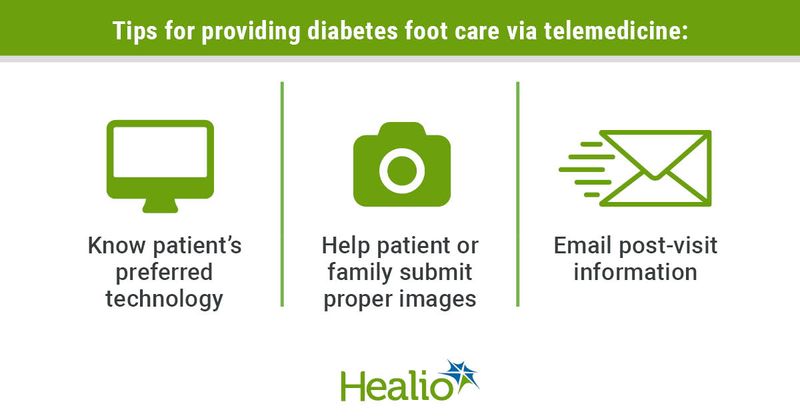Tips for providing diabetes foot care through telemedicine
Communication, the use of visual tools, and providing detailed patient education and resources can help providers successfully navigate telemedicine for diabetic foot care, according to a presenter.

“The COVID-19 pandemic was an unprecedented time in history for the entire global community,” Laura Shin, DPM, PhD, assistant professor of clinical surgery in the department of vascular/endovascular surgery at the Keck School of Medicine of the University of Southern California, told Healio. “Providing access to care to our highest-risk patients helped us look for opportunities to reach our patients at home. Telemedicine was one avenue that we can better utilize to help ensure care and support of all of our patients.”

Shin discussed telemedicine strategies for diabetic foot care at the American Diabetes Association Scientific Sessions.
Before the COVID-19 pandemic, foot evaluations — including wound debridement, off-loading, radiographs, dressing recommendations and infection control — required in-person visits. With the pandemic closing clinics and canceling hospital services, providers had to explore different ways to continue monitoring people in need of diabetic foot care.
At the University of Southern California, providers were forced to make a rapid shift to telemedicine when COVID-19 stay-at-home orders began. In the 6 weeks before the pandemic, all patient contacts for diabetes foot care took place through clinic visits. In the first 6 weeks after COVID-19 lockdowns, however, there were 113 telemedicine visits vs. 86 clinic visits. Although the number of clinic visits has increased since then, Shin said, about 20% of visits are still done via telemedicine today.
Shifting to telemedicine
The shift to telemedicine forced providers to get creative with visits. Shin said there are several positives and negatives with using telemedicine for diabetes foot care.
“The positives are that we can communicate with our patients no matter what, and even if they are unable to make their visits or sick at home, we can still provide care and direction,” Shin told Healio. “The negatives are that often the physical examination is critical in our decision-making and we need to lay hands and can provide care for these patients.”
To maximize the quality of care done virtually, patients were provided resources for a 3-minute foot exam. These resources helped people with diabetes foot complications and their families identify high-risk limbs. Providers also communicated with caregivers and home care nurses who were in more direct contact with patients to monitor their condition. Those at high risk for diabetic foot complications who did not have active wounds were monitored through submitted photographs.
For those with a diabetic foot ulcer, antibiotics were prescribed and limited in-person appointments conducted. Once wound healing was completed, outpatient care continued in a remission clinic. Emphasis was placed on patient education and self-care to help prevent further complications. Providers used online ordering ensure patients had access to proper footwear and devices.
Tips for conducting virtual diabetic foot care
Shin said there are several ways providers can help patients use telemedicine in diabetic foot care. Before conducting appointments, providers should familiarize themselves with the technology. This allows them to assist patients in getting comfortable with the platform. Shin said providers should also be flexible and open to do appointments over the phone or with HIPAA-compliant Zoom-like platforms that may be easier for patients. An important aspect to diabetic foot care is visual images of the foot. Providers should work with the patient to get images of their foot on video or have a family member or caregiver submit photographs.
Another key is keeping an open line of communications with the patients. After a visit, providers should email directions and correspondence to make sure the patients have specific instructions for next steps of care.
“With COVID-19, we have learned a lot about accessing patients,” Shin said during a virtual presentation. “Utilizing different tools and avenues of telemedicine was extremely helpful for us and for our patients with diabetes and for diabetic foot care. While it’s not a replacement for a lot of these inpatient visits, we were still able to manage to keep a lot of these patients safe, keep them out of the hospital and keep them moving in the world. Hopefully, we are able to expand upon that.”

